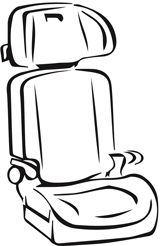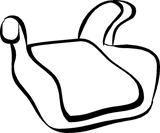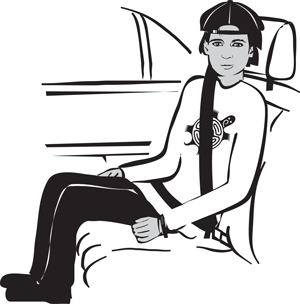 Printable Version
Printable Version
A booster seat provides the best protection for an older child in a sudden stop or crash. An adult seat belt alone doesn't fit a child's body properly. Without a booster seat, an adult seat belt rides too high on a child's belly and neck. This can cause serious injuries to a child in a crash.
Use the YES test to help you decide when your child is ready for a booster seat, and to learn how to use one correctly.
Who should be in a booster seat?
- Once a child has reached the maximum forward-facing weight or height limit of their car seat (as stated by the manufacturer), they should move into a booster seat.
- A child is safest in a booster seat until they reach the maximum weight or height limit of the seat (as stated by the manufacturer).
Getting ready
If you check YES to
all of these points, your child is safest in a booster seat:
- My child has reached the manufacturer’s weight or height limit for the forward-facing car seat.
- My child is less than 145 cm (4 foot 9 inches) tall.
- My child weighs more than 18 kg (40 lbs).
Choosing a booster seat
A booster seat can only be used with a lap-shoulder seat belt. To find the best booster seat for your child, decide where in the back seat your child will sit. Check to see if that vehicle seat has a head rest (head restraint).
- The vehicle
DOES NOT have a head rest:
Choose: - a
high back booster to give the child head and neck support. Some car seats convert from a forward-facing seat with a 5-point harness to a high back booster seat. Some high back booster seats have a head and neck support that can be adjusted as your child grows.
- The vehicle
HAS a head rest:
Choose: - a
high back booster or
- a
backless booster that has a seat base with arm rests. This style of booster works well in a vehicle with a head rest.
|
 High back booster
High back booster
 Backless booster
Backless booster |
Using a booster seat correctly
Use the booster seat for every ride. You’re using the booster seat correctly when you can check
YES to all of these points:
- I’ve read the booster seat instructions and the vehicle owner’s manual.
- The booster seat is in the back seat of the vehicle.
- The shoulder belt is across the centre of my child's chest and the lap belt is across my child’s hips.
- My child's booster seat is never placed in front of an airbag.
Moving to a seat belt
Your child is safest in a booster seat until they reach the maximum weight or height limit of the booster seat (as stated by the manufacturer). A child is ready to ride in the vehicle without a booster seat when the vehicle seat belt fits properly. This is typically when a child is 145 cm (4 feet 9 inches) tall and between 8 and 12 years of age.
The seat belt fits your child properly when
- They are at least 145 cm (4 feet 9 inches) tall
- Their knees bend comfortably at the edge of the seat when sitting all the way back
- The lap belt stays low and snug across the hip bones
- The shoulder belt crosses the chest and stays between your child's neck and shoulder
- They can sit like this for the whole trip without slouching
Until you can check all 5 boxes, your child should continue to use a booster seat.

Did you know?
- Booster seats are the safest choice for children who have outgrown their forward-facing car seats.
- Using a booster seat until the vehicle seat belt fits properly provides the safest ride.
- A child is 3 1/2 times more likely to be hurt in a crash when using an adult seat belt alone than when buckled in a booster seat.
- All children under the age of 13 are safest riding in the back seat.
For more information:
